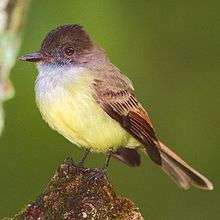Tyranni
The Tyranni (suboscines) are a clade of passerine birds that includes more than 1,000 species, the large majority of which are South American. It is named after the type genus Tyrannus.
| Tyranni | |
|---|---|
 | |
| Dusky-capped flycatcher (Myiarchus tuberculifer) | |
| Scientific classification | |
| Kingdom: | Animalia |
| Phylum: | Chordata |
| Class: | Aves |
| Order: | Passeriformes |
| Suborder: | Tyranni |
| Infraorders | |
|
(but see text) | |
These have a different anatomy of the syrinx musculature than the oscines (songbirds of the larger suborder Passeri), hence its common name of suboscines. The available morphological, DNA sequence, and biogeographical data, as well as the (scant) fossil record, agree that these two major passerine suborders are evolutionarily distinct clades.
Systematics
The suborder Tyranni is divided into two infraorders: the Eurylaimides and the Tyrannides. The New Zealand wrens in the family Acanthisittidae are placed in a separate suborder Acanthisitti.[1]
The Eurylaimides contain the Old World suboscines – mainly distributed in tropical regions around the Indian Ocean – and a single American species, the sapayoa:[1]
- Philepittidae: asities
- Eurylaimidae: typical broadbills
- Calyptomenidae: African and green broadbills
- Sapayoidae: broad-billed sapayoa
- Pittidae: pittas
Phylogenetic relationships of the Eurylaimides based on Oliveros et al. (2019):[1]
| Eurylaimides |
| |||||||||||||||||||||||||||
The Tyrannides contain all the suboscines from the Americas, except the broad-billed sapayoa. The families listed here are those recognised by the International Ornithologists' Union (IOC).[2]
- Pipridae: manakins
- Cotingidae: cotingas
- Tityridae: tityras, sharpbill, becards (includes Oxyruncus and Onychorhynchus)
- Tyrannidae: tyrant-flycatchers (includes Piprites, Platyrinchus, Tachuris and Rhynchocyclus)
- Melanopareiidae: crescent chests
- Conopophagidae: gnateaters and gnatpittas
- Thamnophilidae: antbirds
- Grallariidae: antpittas
- Rhinocryptidae: tapaculos
- Formicariidae: antthrushes
- Furnariidae: ovenbirds and woodcreepers (includes Dendrocolaptidae)
Phylogenetic relationships of the Tyrannides based on Oliveros et al. (2019):[1]
| Tyrannides |
| ||||||||||||||||||||||||||||||||||||||||||||||||||||||||||||
This group has been separated into three parvorders by Sibley & Ahlquist. However, DNA-DNA hybridization has shown to be not very well suited to reliably resolve the suboscine phylogeny. It was eventually determined that there was a simple dichotomy between the antbirds and allies (tracheophones), and the tyrant-flycatchers and allies.[3] Given that the "parvorder" arrangement originally advanced is certainly obsolete (see e.g. Irestedt et al. 2002 for tracheophone phylogeny) - more so if the Eurylaimides are elevated to a distinct suborder - it would be advisable to rank the clades as superfamilies, or if the broadbill group is considered a separate suborder, as infraorders. In the former case, the name Furnarioidea would be available for the tracheophones, whereas "Tyrannoidea", the "bronchophone" equivalent, has not yet been formally defined.[4] In the latter case, the tracheophones would be classified as "Furnariides",[5] while the Tyrannides would be restricted to the tyrant-flycatchers and other "bronchophone" families.
The tracheophones contain the Furnariidae, Thamnophilidae, Formicariidae (probably including most tapaculos), and Conopophagidae. The tyrant-flycatcher clade includes the namesake family, the Tityridae, the Cotingidae, and the Pipridae.
References
- Oliveros, C.H.; et al. (2019). "Earth history and the passerine superradiation". Proceedings of the National Academy of Sciences of the United States of America. 116 (16): 7916–7925. doi:10.1073/pnas.1813206116. PMC 6475423. PMID 30936315.
- Gill, Frank; Donsker, David; Rasmussen, Pamela, eds. (2020). "Family Index". IOC World Bird List Version 10.1. International Ornithologists' Union. Retrieved 24 April 2020.
- A conceivable vernacular name would be "bronchophones". This would parallel the German vernacular names, Luftröhrenschreier (tracheophones) and Bronchienschreier (bronchophones).
- And thus should not be used without quotation marks.
- See remark at "Tyrannoidea". This peculiarity is explained by the fact that Sibley & Ahlquist's analyses erroneously suggested an overly complex phylogeny for the tracheophones, and a much simpler one for the tyrant-flycatchers and allies.
Further reading
- Ohlson, J.I.; Irestedt, M.; Ericson, P.G.P.; Fjeldså, J. (2013). "Phylogeny and classification of the New World suboscines (Aves, Passeriformes)". Zootaxa. 3613 (1): 1–35. doi:10.11646/zootaxa.3613.1.1.
- Irestedt, Martin; Fjeldså, Jon; Johansson, Ulf S. & Ericson, Per G.P. (2002): Systematic relationships and biogeography of the tracheophone suboscines (Aves: Passeriformes). Molecular Phylogenetics and Evolution 23(3): 499–512. doi:10.1016/S1055-7903(02)00034-9 (HTML abstract)
- Selvatti, A.P.; Galvão, A.; Pereira, A.G.; Pedreira Gonzaga, L.; Russo, C.A.D.M. (2017). "An African origin of the Eurylaimides (Passeriformes) and the successful diversification of the ground-foraging pittas (Pittidae)". Molecular Biology and Evolution. 34 (2): 483–499. doi:10.1093/molbev/msw250.